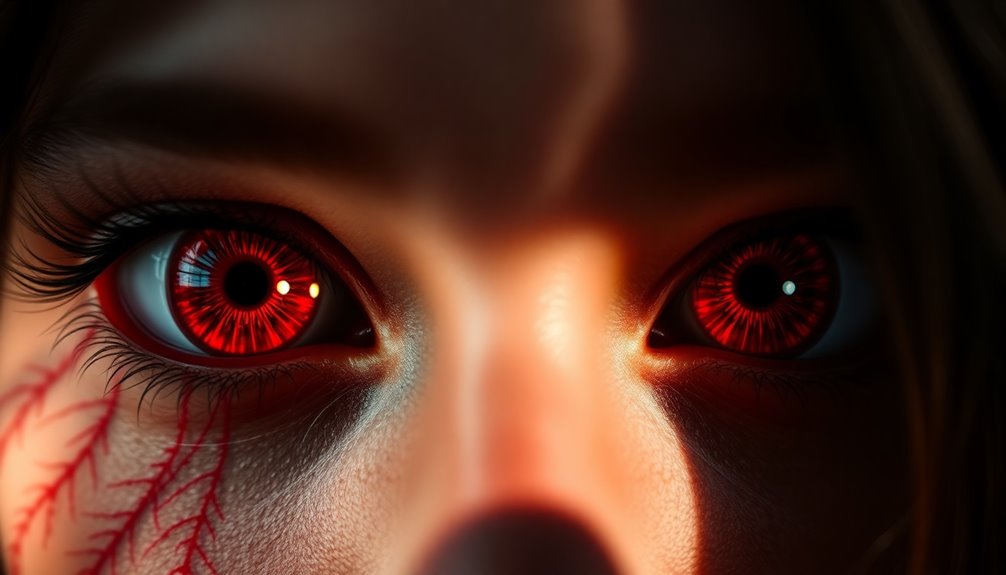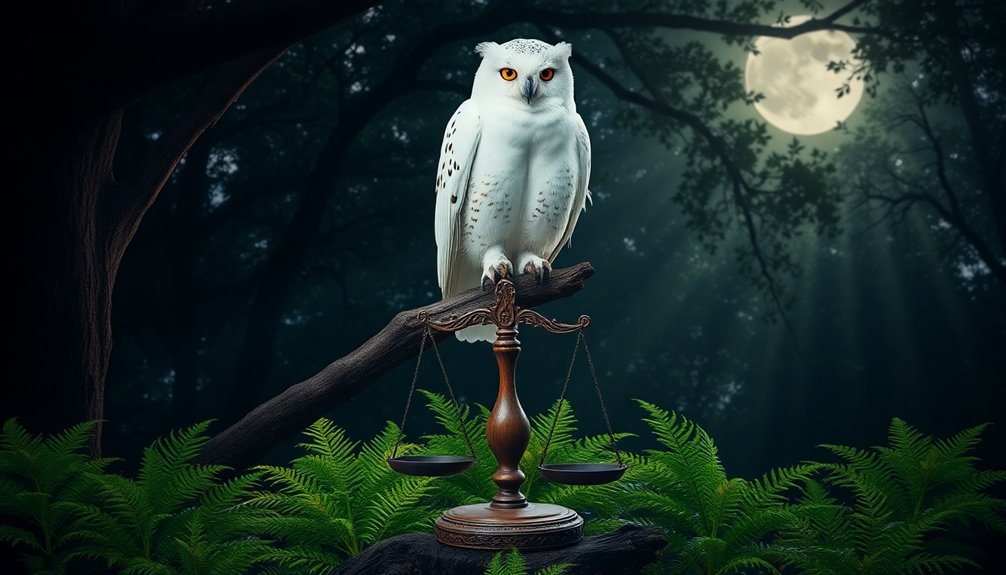Red eyes carry intense spiritual symbolism, often representing powerful emotions like anger and passion. They can signify deeper internal struggles or encourage a spiritual awakening. In various cultures, red eyes serve as warnings of danger or malevolence, connecting to unresolved trauma needing attention. When encountered in dreams, they may reflect hidden fears or internal conflicts that urge you to confront your emotions. While they can symbolize transformation and self-discovery, they also warn of potential malevolent forces. If you want to understand the layers behind these crimson gazes, there's more to uncover about their rich meanings.
Key Takeaways
- Red eyes symbolize powerful emotions and serve as warnings of danger or malevolence across various cultures.
- They reflect internal conflicts and highlight spiritual awakenings, representing the duality of good and evil.
- Dreams featuring red eyes indicate hidden fears and unresolved emotional struggles that require attention.
- Red eyes can signify internalized anger and suppressed trauma, urging individuals to confront their emotional baggage for healing.
- They may also represent spiritual connections or potential malevolent forces, prompting discernment in navigating emotional and spiritual challenges.
Definition and Symbolism of Red Eyes
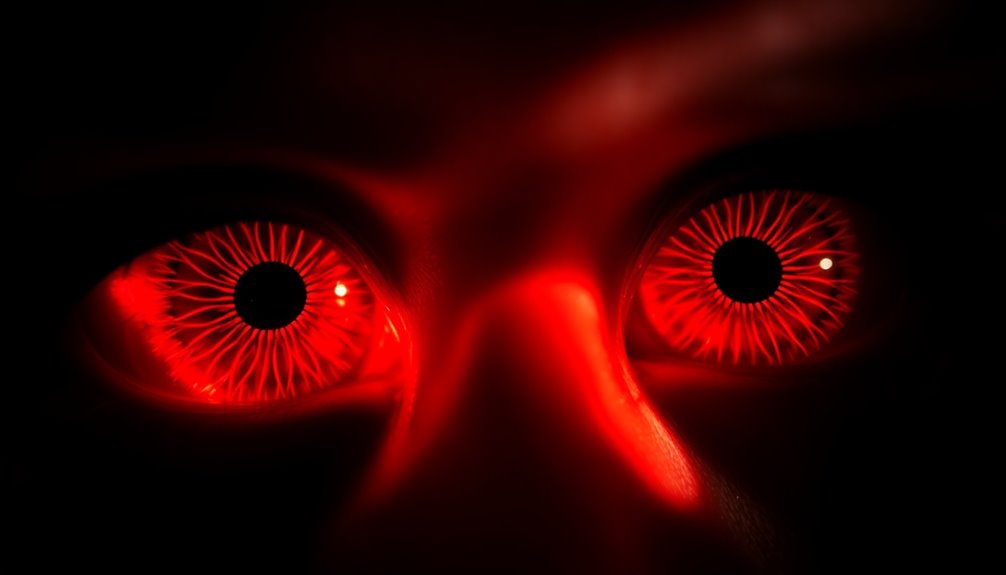
Red eyes symbolize a range of powerful emotions and warnings across various cultures and narratives. Often seen as a warning sign, red eyes can indicate danger or malevolence, echoing the saying, "Red sky at morning, sailors take warning." This connection to ominous signals suggests that when you encounter red eyes, it's crucial to pay attention to the underlying intensity of the situation.
In storytelling, characters with red eyes often undergo transformation, embodying both passion and unresolved trauma. These eyes can reflect internal conflicts and signify a spiritual awakening, highlighting a character's journey through personal growth.
The biblical symbolism of red eyes further reinforces the duality of good and evil, showing that intense emotions can lead to both destruction and enlightenment.
When you see red eyes, consider the spiritual meaning behind them. They can act as a reminder of the intense emotions you carry, urging you to confront your passions and unresolved issues.
Embrace this symbolism as an invitation to explore your inner landscape, fostering transformation and growth within yourself. Red eyes aren't just a visual cue; they represent a deeper narrative of emotional and spiritual depth.
Emotional Interpretations in Dreams
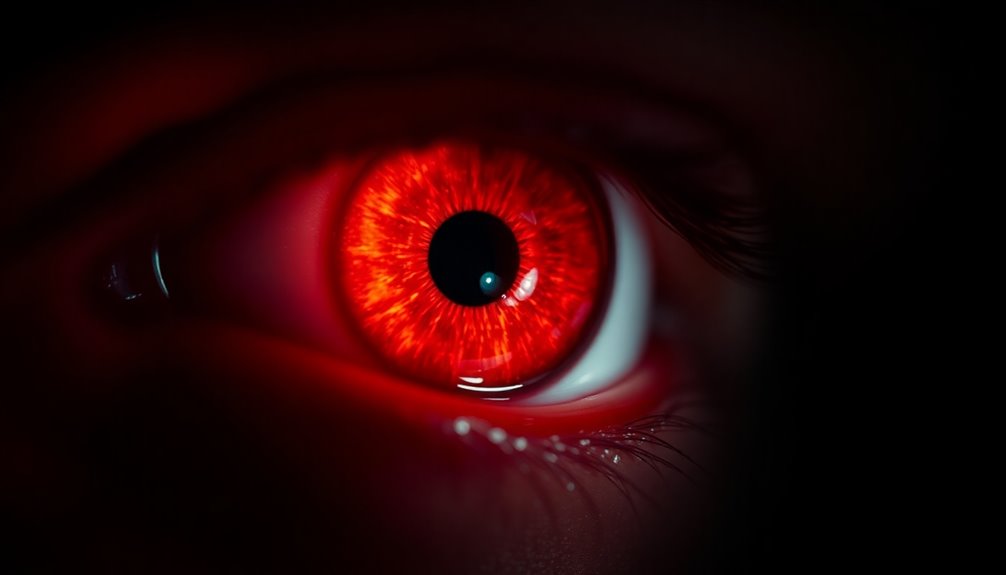
When you dream of red eyes, it often reveals hidden fears and desires bubbling beneath the surface.
These dreams can also highlight internal conflicts and struggles that you may be facing in your waking life.
Hidden Fears and Desires
Have you ever woken up from a dream featuring haunting red eyes, feeling an inexplicable weight on your chest? Those crimson gazes can reveal much about your inner world, and understanding them can lead to valuable insights. Consider these points:
- Red eyes often symbolize hidden fears that linger in your subconscious.
- They may indicate unresolved emotional conflicts needing your attention.
- Dreams with red eyes can reflect deep-seated desires that you're repressing.
- The context of the dream is essential for understanding your emotional state.
When you see red eyes in your dreams, it might signal a subconscious struggle, urging you to confront your internal struggles.
These dreams often act as a warning sign, highlighting self-destructive behaviors or paths you've been avoiding. They encourage self-exploration and reflection on your emotional state.
You might feel overwhelmed by your emotions, but acknowledging these hidden fears and desires can lead to healing.
Internal Conflicts and Struggles
Dreams featuring red eyes often act as a mirror, reflecting the internal conflicts and struggles you face in your waking life. These dreams can symbolize unresolved emotions like anger or fear, urging you to confront what lies beneath the surface. Recognizing this can lead to transformation and healing. Additionally, understanding the impact of narcissistic relationships can provide deeper insights into the emotional turmoil represented by these dreams. Research shows that narcissistic abuse often leaves lasting effects, which can manifest in your subconscious.
| Symbol | Interpretation | Emotional Connection |
|---|---|---|
| Red | Represents intense emotions and desires | Anger, passion, fear |
| Eyes | Mirrors insight and self-reflection | Awareness of internal conflicts |
| Internal Conflicts | Indicates unresolved issues | Struggles with self-directed anger |
As you navigate these vivid symbols, it's essential to engage in self-reflection. Your dreams might highlight feelings of intimidation or the weight of overwhelming situations. By acknowledging these internal conflicts, you pave the way for healing. Embrace the journey of understanding your emotions, as doing so can reveal powerful insights and foster personal growth. Ultimately, the red eyes in your dreams serve as a call to explore and address the desires and fears that shape your emotional landscape.
Emotional Exhaustion and Reflection
Red eyes in your dreams can be a powerful indicator of emotional exhaustion, often stemming from stress or unresolved conflicts. When you encounter these crimson gazes, it's important to reflect on their meaning. Here are some interpretations to contemplate:
- Emotional Exhaustion: Red eyes can symbolize your fatigue from overwhelming situations.
- Unresolved Internal Conflicts: These dreams may point to issues you haven't faced yet, urging you to confront them.
- Hidden Fears: The intensity of red eyes often highlights fears you might be avoiding, calling for introspection.
- Personal Growth: Engaging with these dreams can foster emotional balance and facilitate growth.
As you navigate these intense emotions, take time for self-reflection. Acknowledge the stress and the internal struggles you face.
The presence of red eyes serves as a reminder to process your feelings constructively, addressing pent-up anger or frustration. By embracing this introspection, you can restore emotional balance and clarity in your life.
Ultimately, dreams featuring red eyes encourage you to confront your hidden fears, paving the way for personal development and emotional healing.
Anger and Unresolved Trauma

When you dream of red eyes, it often signals internalized anger that's waiting to be addressed.
This manifestation can point to unresolved trauma that's been weighing you down, impacting your emotional health.
Recognizing this can be the first step toward healing your emotional baggage and finding peace.
Internalized Anger Manifestation
Internalized anger often manifests in subtle yet powerful ways, one of which can be the symbolism of red eyes. When you encounter red eyes in dreams, it's essential to recognize what they can represent:
- Unresolved trauma that's lurking beneath the surface.
- Suppressed aggression waiting for an outlet.
- Emotional struggles that demand your attention.
- A call for self-reflection to foster personal growth.
These crimson gazes can reflect your internalized anger, highlighting feelings you might be too afraid to confront. If you're dreaming of red eyes, it might signal the need to address intimidation or fear lingering in your waking life.
Ignoring these messages can lead to detrimental outcomes, as unaddressed emotions could escalate into harmful behaviors. Recognizing the symbolism of red eyes can encourage you to confront your feelings and work through that emotional baggage. This acknowledgment is the first step toward healing.
By delving into these emotional struggles, you create an opportunity for personal growth, transforming internalized anger into understanding and strength. Additionally, exploring your feelings through practices like positive thinking can help you navigate this challenging emotional landscape.
Don't shy away from seeking help if needed; your path to healing begins with facing the truth.
Healing Emotional Baggage
Healing emotional baggage, particularly related to anger and unresolved trauma, is an important journey that can lead to profound personal transformation. When you dream of red eyes, it often symbolizes suppressed emotional trauma and internal conflicts, highlighting your need for healing. These dreams might indicate feelings of being overwhelmed or judged, pushing you to confront your unresolved issues.
Recognizing the symbolism of red eyes can serve as a powerful prompt for self-reflection. It's a chance to explore the anger you've directed at yourself and others, which is crucial for your personal growth. Engaging in therapy can provide you with the tools to process these emotions effectively, fostering emotional healing and resilience.
Consider practices like journaling, which can help you articulate feelings linked to red eyes. By doing so, you create space for understanding and addressing your anger, allowing you to move forward.
Passion and Spiritual Awakening
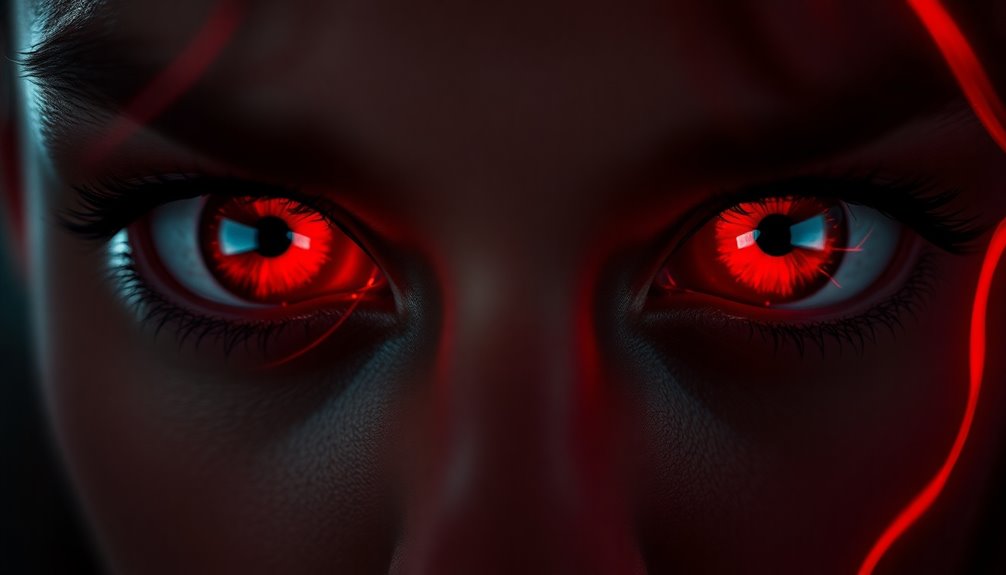
In the journey of self-discovery, red eyes often emerge as a powerful symbol of passion and spiritual awakening. They reflect your intense emotions and a deep desire for self-expression. When you encounter red eyes, whether in dreams or in reality, you might find yourself at a pivotal moment of emotional transformation. This experience can lead to profound insights and personal growth.
Here are four key aspects of how red eyes relate to passion and spiritual awakening:
- Heightened Awareness: Red eyes can signal a readiness to confront hidden feelings and explore your true identity.
- Inner Guidance: They urge you to remain vigilant and attuned to your spiritual path.
- Mindfulness: Channeling your intense emotions constructively fosters self-reflection and deeper understanding.
- Divine Connections: Reddish eyes often symbolize encounters with the divine or moments of significant change.
Embracing the symbolism of red eyes allows you to navigate your emotional landscape, aiding in your spiritual awakening.
Demonic Presence and Spiritual Warfare
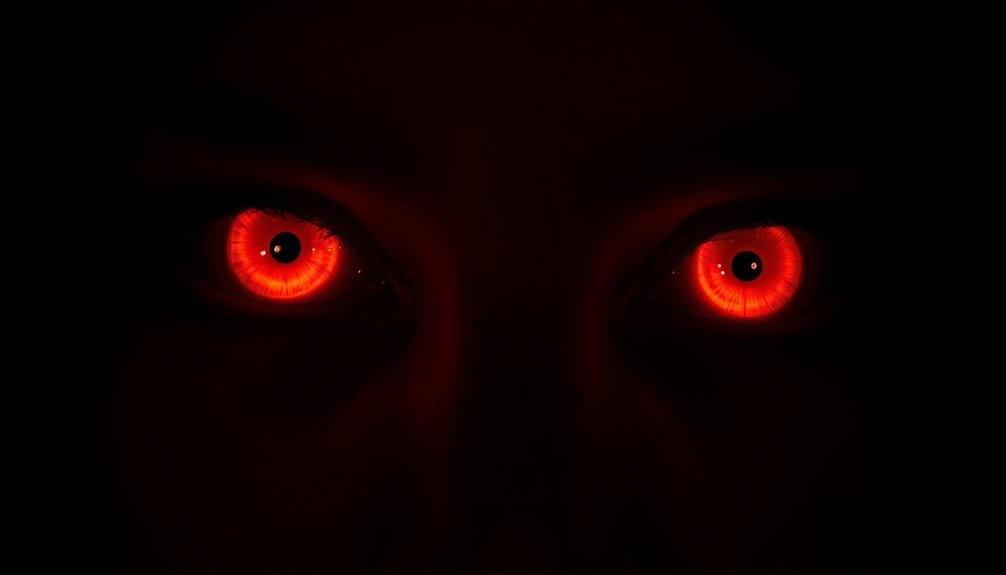
Red eyes often signal a demonic presence, raising alarms in your spiritual awareness. In many spiritual beliefs, these crimson gazes symbolize not just danger, but manipulation and the influence of evil forces. Biblical texts frequently connect red eyes to divine wrath and judgment, serving as stark warnings against moral corruption and spiritual peril.
When you encounter red eyes, whether in dreams or reality, it can indicate heightened aggression and a loss of control—key elements of spiritual warfare. This imagery suggests you're vulnerable to spiritual attacks, compelling you to remain vigilant.
Recognizing red-eyed entities in your dreams may prompt you to seek deeper spiritual guidance, as it emphasizes the importance of discernment. In this context, the presence of red eyes serves as a reminder to guard against deception and negativity.
By staying aware of these signals, you can better navigate the challenges posed by malevolent forces. Embrace spiritual practices that fortify your defenses, enabling you to confront the darker aspects of existence with courage and clarity.
Your journey through this spiritual landscape is essential for maintaining peace and integrity amidst potential threats.
Cultural Perspectives on Red Eyes

Encountering red eyes in various cultural contexts reveals a rich tapestry of meanings shaped by societal beliefs and fears.
Here's a glimpse into some interpretations:
- Anger and Rage: In many cultures, red eyes symbolize intense emotions like anger and danger, reflecting deep-seated fears tied to aggression.
- Spiritual Awareness: Native American traditions often see red eyes as indicators of heightened spiritual awareness, suggesting a strong connection to the spiritual domain.
- Destructive Energy: Ancient Egyptians linked red eyes to destructive energy, representing divine wrath or the repercussions of moral failings.
- Supernatural Beings: Folklore frequently associates red eyes with supernatural beings, such as demons or spirits, evoking caution and fear in those who encounter them.
In Western cultures, red eyes can embody passion and intensity, highlighting the emotional depth related to personal experiences and relationships.
These varied cultural perspectives illustrate how red eyes serve as powerful symbols, encompassing a spectrum of emotional states and spiritual meanings.
From the domain of fear to the heights of emotional passion, red eyes continue to intrigue and challenge our understanding of their significance across different cultures.
Common Dream Scenarios
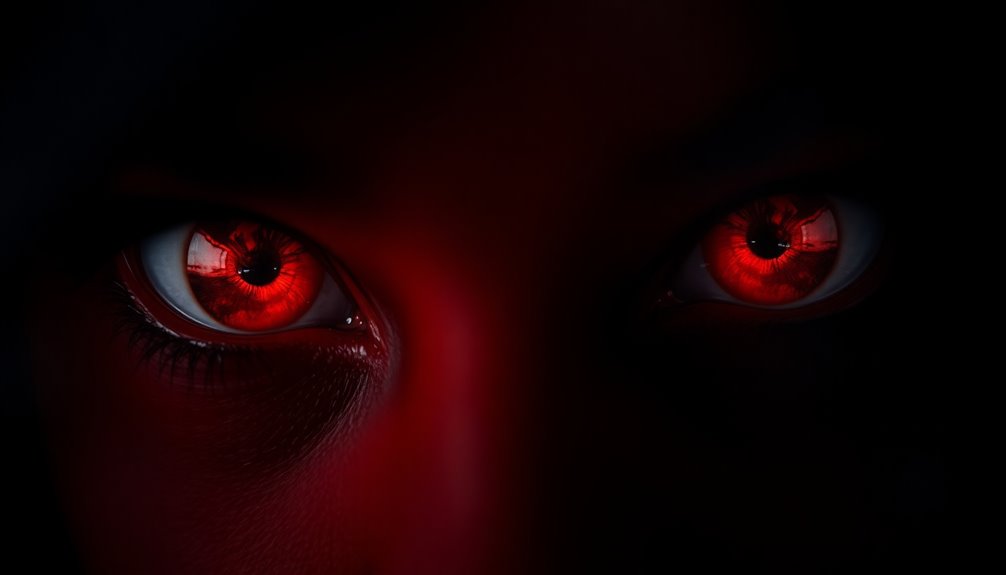
Dreams featuring red eyes can evoke a sense of unease and reflection, often pointing to underlying emotions or conflicts in your waking life. These dreams can symbolize various feelings, from intimidation to unresolved conflicts, and may lead you toward spiritual enlightenment or significant transformation.
| Dream Scenario | Interpretation |
|---|---|
| Seeing someone with red eyes | Reflects feelings of intimidation or internalized anger. |
| Encountering red-eyed creatures | Signifies external threats or deep-seated anxieties. |
| Observing your own red eyes | Indicates an internal struggle with overwhelming emotions. |
| Witnessing red eyes as a warning sign | Prompts self-reflection on your current path and unresolved issues. |
In these scenarios, red eyes highlight the need to confront your overwhelming emotions and acknowledge any internal conflicts. They serve as a warning sign, urging you to assess your feelings and circumstances. By embracing this self-reflection, you can tap into your inner strength, face your fears, and ultimately find a path toward healing and growth. Additionally, the importance of emotional support during challenging times can be a key factor in navigating these feelings. Your dreams are not just a reflection of your psyche; they're a call to action for your personal development.
Self-Reflection and Personal Growth
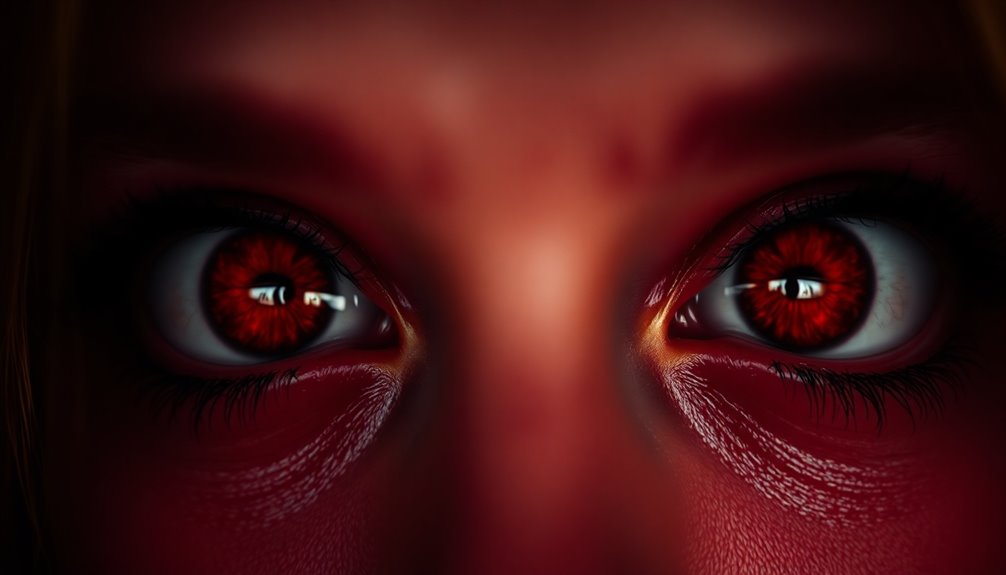
Exploring the messages behind unsettling dreams can lead to profound insights about your emotional landscape. The symbolism of red eyes often reflects intense emotions and unresolved trauma, urging you to look deeper. Here are some key aspects to reflect upon:
- Self-Reflection: Take time to examine your thoughts and feelings, understanding how they relate to your experiences. Engaging in nighttime meditation can enhance your ability to process these emotions. Additionally, developing emotional resilience is crucial for navigating your inner turmoil and fostering growth. Understanding your own temperament can also aid in this self-exploration process. Dreams often reveal underlying fears, which can significantly impact your emotional health.
- Journaling: Documenting your emotions can reveal patterns or conflicts that block your personal growth.
- Seeking Guidance: Professional support, like therapy, can help address underlying issues and promote healing.
- Emotional Resilience: Confronting your fears and intense emotions can foster a stronger, more resilient self.
Embracing self-reflection not only leads to a deeper understanding of your passions but also harnesses the transformative energy that red eyes symbolize. Additionally, utilizing skills from effective communication techniques can enhance your relationships and emotional health.
As you journey through this process, you'll cultivate emotional resilience and facilitate your spiritual development. Personal growth often arises from confronting uncomfortable truths, and this transformation can be profoundly rewarding.
Frequently Asked Questions
What Does the Red Eye Mean Spiritually?
When you encounter red eyes spiritually, it often symbolizes heightened awareness and emotional intensity.
These crimson gazes can indicate a deeper connection to your inner self and the spiritual domain, prompting you to reflect on your feelings and experiences.
In some cultures, red eyes serve as warnings or reminders of moral responsibilities.
Embracing this symbolism might encourage you to confront inner struggles and seek personal growth, transforming challenges into opportunities for healing.
What Does a Super Red Eye Mean?
They say, "The eyes are the windows to the soul."
When you see a super red eye, it often signals intense emotions like passion or anger bubbling beneath the surface.
It might urge you to confront unresolved issues or awaken your spiritual journey.
This vivid imagery also suggests feelings of being scrutinized, prompting you to reflect on your choices.
What Does the Bible Say About Red Eyes?
The Bible often associates red eyes with divine judgment and anger, reflecting God's fierce stance against sin.
You'll find references indicating that red can symbolize danger and moral corruption, warning against evil influences.
Additionally, red eyes can represent heightened spiritual awareness, urging you to discern deception.
This imagery serves as a reminder to stay vigilant and protect yourself from malevolent forces, emphasizing the importance of spiritual discernment in your life.
What Does the Eye Symbolize Spiritually?
Imagine gazing into a deep, endless ocean; the eye symbolizes that vastness within you.
Spiritually, it represents perception and intuition, urging you to see beyond the surface. It's a gateway to profound truths, guiding your journey toward enlightenment.
In many cultures, the eye also serves as a protective shield against negativity.
Embracing this symbolism can deepen your connection to your inner self and the universe, illuminating your path with insight and clarity.
Conclusion
In the grand tapestry of life, red eyes aren't just a quirky detail; they're a fiery beacon of our deepest emotions, a siren call to confront our inner demons or ignite our passions! Whether you're dreaming of crimson gazes or facing them in daily life, these intense symbols urge you to dive deeper into your soul. So, keep your eyes peeled for these vibrant signals—they might just lead you to an epic journey of self-discovery and transformation!

